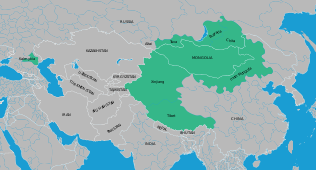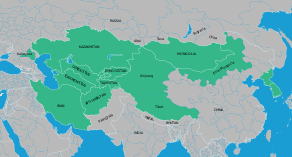Inner Asia
Inner Asia refers to landlocked regions within East Asia and North Asia that are part of today's Western China, Mongolia, the Russian Far East and Siberia. It overlaps with some definitions of Central Asia, mostly the historical ones, but certain regions that are sometimes included as part of Inner Asia (such as Northeast China) are not considered a part of Central Asia by any of its definitions. Inner Asia may be considered as the "frontier" of China, and as bounded by East Asia, which consists of China, Japan, and Korea.[1]
The extent of Inner Asia was seen differently in different periods. "Inner Asia" is sometimes contrasted to "China Proper", that is, the original provinces, those with majority Han Chinese populations. In 1800 it consisted of four main areas, namely Manchuria (modern Northeast China and Outer Manchuria), Mongolia (Inner and Outer), Xinjiang and Tibet. These areas had been recently conquered by the Qing dynasty but were governed through different administrative structure[2] not as regular provinces during most of the Qing period. The Qing government agency known as the Lifan Yuan was established to supervise the empire's Inner Asian regions.
Definition and usage[]

Inner Asia has a range of definitions and usages.[3] One such is how Denis Sinor used Inner Asia in contrast to agricultural civilizations, noting its changing borders, such as when a Roman province was taken by the Huns, areas of North China was occupied by the Mongols, or when Anatolia came under Turkish influence, eradicating Hellenistic culture.[4]
Another is how scholars or historians of the Qing dynasty such as those of the New Qing History often use the term "Inner Asia" when studying Qing interests or reigns outside China proper.[5]
Different languages[]
In French, "Asie centrale" can mean both "Central Asia" and "Inner Asia"; Mongolia and Tibet by themselves are termed "Haute-Asie" (High Asia, or Upper Asia).[6]
The terms meaning "Inner Asia" in the languages of Inner Asian peoples are all modern loan translations of European, mostly Russian, terms.[citation needed]
Related terms[]
Central Asia[]
"Central Asia" normally denotes the western, Islamic part of Inner Asia; that is, Kazakhstan, Kyrgyzstan, Tajikistan, Turkmenistan, and Uzbekistan, with Afghanistan and Iran sometimes also included as part of Central Asia. However, The Library of Congress subject classification system treats "Central Asia" and Inner Asia as synonymous.[6]
Central Eurasia[]
According to Morris Rossabi, the term "Inner Asia" is the well-established term for the area in the literature. However, because of its deficiencies, including the implication of an "Outer Asia" that does not exist, Denis Sinor has proposed the neologism "Central Eurasia", which emphasizes the role of the area in intercontinental exchange.[7] According to Sinor:[8]
The definition that can be given of Central Eurasia in space is negative. It is that part of the continent of Eurasia that lies beyond the borders of the great sedentary civilizations.... Although the area of Central Eurasia is subject to fluctuations, the general trend is that of diminution. With the territorial growth of the sedentary civilizations, their borderline extends and offers a larger surface on which new layers of barbarians will be deposited.
See also[]
- China proper
- Chinese Tartary
- Western Regions
- Tang dynasty in Inner Asia
- Yuan dynasty in Inner Asia
- Qing dynasty in Inner Asia
- Nomadic empire
- Eurasianism
- Silk Road
- Turco-Mongols
- Turanism
- Tartary
- Division of the Mongol Empire
- History of Manchuria
- History of Mongolia
- History of Tibet
- History of Xinjiang
References[]
Citations[]
- ^ Bulag, Uradyn E. (October 2005). "Where is East Asia? Central Asian and Inner Asian Perspectives on Regionalism". Japan Focus.
- ^ The Cambridge History of China: Volume 10, Part 1, by John K. Fairbank, p37
- ^ Book Abstaract: "Inner Asia: Making a Long-Term U.S. Commitment." Archived 2011-06-04 at the Wayback Machine Authors: Carol D. Clair; Army War Coll Carlisle Barracks Pa. Retrieved: 22 August 2009.
- ^ The Cambridge history of early Inner Asia, Volume 1 By Denis Sinor. Retrieved: 22 August 2009.
- ^ New Qing Imperial History: The Making of Inner Asian Empire at Qing Chengde, edited by Ruth W. Dunnell, Mark C. Elliott, Philippe Foret, James A Millward
- ^ Jump up to: a b Research Institute for Inner Asian Studies (RIFIAS). Indiana University in Bloomington, Indiana. Retrieved: 22 August 2009.
- ^ Rossabi, Morris (1975). China and Inner Asia: from 1368 to the present day. Pica Press. p. 10.
- ^ Sinor, Denis (1997). Inner Asia: History, civilization, languages: a syllabus. p. 4.
Sources[]
- Di Cosmo, Nicola. 1999. "State Formation and Periodization in Inner Asian History". Journal of World History 10 (1). University of Hawai'i Press: 1–40. State Formation and Periodization in Inner Asian History.
- Rogers, J. Daniel. 2012. "Inner Asian States and Empires: Theories and Synthesis". Journal of Archaeological Research 20 (3). Springer: 205–56. Inner Asian States and Empires: Theories and Synthesis.
External links[]
- Inner Asia
- Regions of Asia
- Natural history of Asia
- Historical regions


